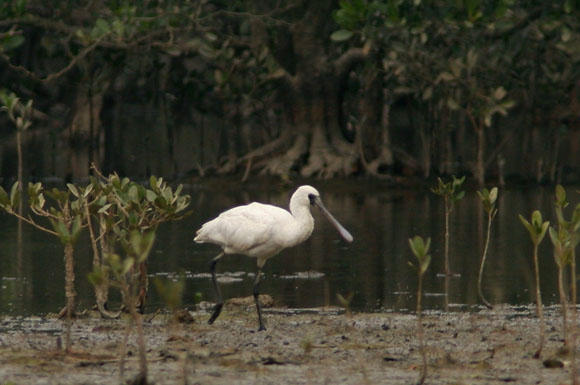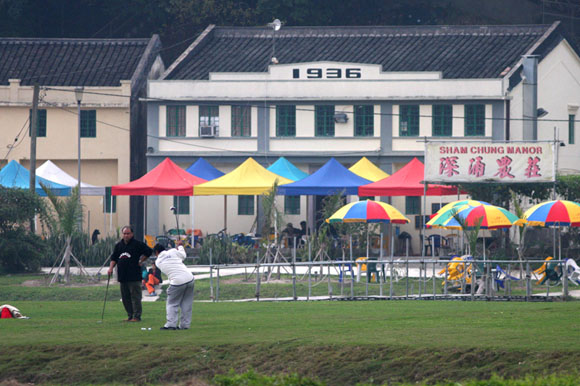
Miscellany (pdf)
|
Environmentally friendly mariculture - challenges of marine fish culture in Mainland China |
|
| Birdbrains in Big Bird Race 2006 | |
|
Kadoorie Farm & Botanic Garden - wildlife updates & sightings |
Will Luk Keng become another Sham Chung? (pdf)
by
Fion Cheung
Luk Keng is the largest (32 ha) freshwater marsh in Hong Kong (Dudgeon & Chan, 1996). It was designated as a Conservation Area (CA) by the Town Planning Board in 1994 and ranked 4th out of 12 priority conservation sites identified in the New Nature Conservation Policy of Hong Kong (AFCD, 2004) [see the front page article]. With this designation and also the high ranking in the new policy that the government has attributed Luk Keng, the site appears to be well protected. However, no "real" protection or management has ever been implemented. On the contrary, since 1999 disturbing activities, including flying model aeroplanes and helicopters in the freshwater marsh, have been reported to affect water birds which roost and feed there (Wong, 2000 & 2002), especially on Sundays and public holidays. This situation is worrying because, in the monthly bird survey conducted in February 2005, a juvenile Black-faced Spoonbill (Platalea minor), a globally threatened species listed as endangered and with an estimated world population of less than 700 (Viney et al., 2005), was found using Luk Keng as a feeding site (Fig. 1). Three more roosting juveniles were recorded in April 2006 (Fig. 2).
 |
| Fig. 1. A juvenile Black-faced Spoonbill recorded at Luk Keng in December 2005 (Photo: Fion Cheung). |
Besides birds, Luk Keng is also an important site for invertebrates. It has the highest species richness of aquatic macroinvertebrates when compared with other freshwater wetlands in the territory (Dudgeon & Chan, 1996). In a biweekly adult dragonfly survey started in February 2005, more than one third of the total Odonate species in Hong Kong were recorded, including the globally-endangered Four-spot Midget (Mortonagrion hirosei, Figure 3), and six locally-uncommon species (Wilson, 2004): Dusky Lilysquatter (Cercion calamorum), Eastern Lilysquatter (C. melanotum), Blue Sprite (Pseudagrion microcephalum), Chinese Tiger (Gomphidia kelloggi), Coastal Glider (Macrodiplax cora) and Emerald Dwarf (Nannophyopsis clara). Horseshoe crabs (Tachypleus tridentatus) were also found breeding in the mangrove area of Luk Keng.
 |
| Fig. 2. Three juvenile Blacked-faced Spoonbills recorded in April 2006 (Photo: Fion Cheung). |
 |
| Fig. 3. A mating pair of M. hirosei (Photo: Allen To). |
All these data highlight the ecological importance of Luk Keng, just as the wildlife recorded at Sham Chung in the past showed its biological importance. Despite the occurrence of rare species, e.g. Black Paradise Fish Macropodus concolor and Brown Fish Owl Ketupa zeylonensis, the 7 ha Sham Chung freshwater marsh has already been destroyed under the guise of farming–turf grass (Fig. 4). Now, though it is unofficial, Sham Chung has become a golf course (Fig. 5). Although Luk Keng is a CA, "agricultural use" is also permitted. It is of utmost importance that we keep a close watch on Luk Keng and stop any unfavourable activities or development .
Bibliography
AFCD (2004). New nature conservation policy. Agriculture & Fisheries Department, Hong Kong Special Administrative Region Government.
Dudgeon, D. & Chan, E.W.C. (1996). Ecological study of freshwater wetland habitats in Hong Kong. Agriculture & Fisheries Department, Hong Kong Special Administrative Region Government.
Viney, C., Phillipps, K. & Lam, C.Y. (2005). The birds of Hong Kong and South China, 8th edition. Information Services Department, Hong Kong Special Administrative Region Government.
Wilson, K.D.P. (2004). Field guide to the dragonflies of Hong Kong, 2nd edition. Agriculture, Fisheries and Conservation Department, Hong Kong, 372 pp.
Wong, L.C.C. (2000). Luk Keng freshwater marsh. Porcupine! 21. The University of Hong Kong, Hong Kong.
Wong, L.C.C. (2002). Starling Inlet – tommorrow’s empty wetland? Porcupine! 26. The University of Hong Kong, Hong Kong.
See also Porcupine! 16, 19 and 21 and the update on Sham Chung in this issue.
 |
| Fig. 4. Will this heavy machine arrive at Luk Keng one day? (Photo: Allen To). |
 |
| Fig. 5. Nothing is impossible! Building a golf course by filling in an ecologically important freshwater marsh in Hong Kong (Photo: Allen To). |
P.28-29
|
Porcupine! |
 Copyright © 2000 |
